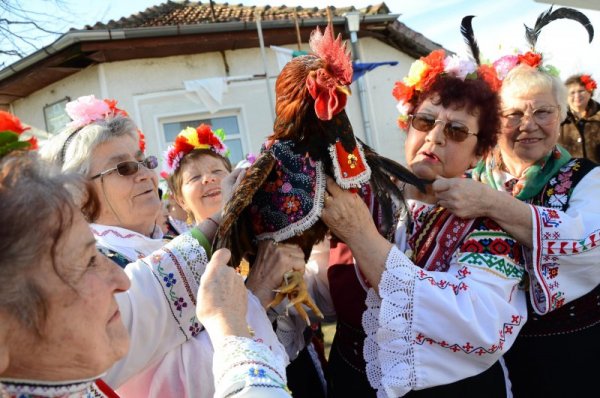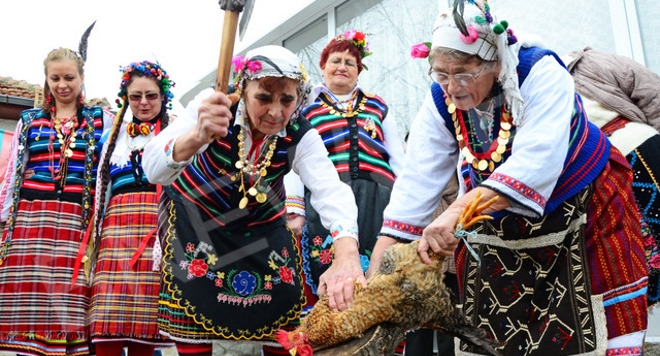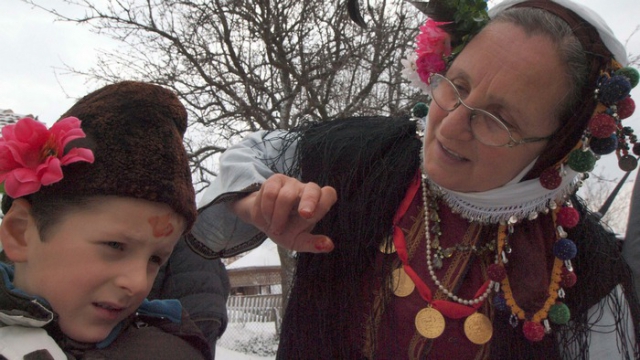OEC: Rooster day (Dzień Koguta)
Rooster day (Dzień Koguta)
In Bulgaria, the 2nd of February is known as Petlovden (Rooster Day). On this day a special ritual is performed that is intended to insure fertility and health of young boys.
The day before Rooster Day, the house is cleaned, washed and whitewashed.
In the morning the oldest woman in the house would catch a healthy and virile bright coloured (in some areas black) rooster specifically grown or purchased to be sacrificed on this day.

W Bułgarii 2 lutego jest znany jako Petlovden (Dzień Koguta). W tym dniu odbywa się specjalny rytuał mający na celu zapewnienie płodności i zdrowia młodych chłopców.
Dzień przed Dniem Koguta dom jest czyszczony, myty i wybielany.
Rano najstarsza kobieta w domu łapie zdrowego i dojrzałego jasnego (na niektórych obszarach czarnego) koguta, specjalnie wyhodowanego, lub zakupionego, w celu poświęcenia go tego dnia.
She would slaughter the rooster on the house threshold (sometimes on the house compound gate) and would make sure to splatter its blood on the door (gate) as well.
Zabija koguta na progu domu (czasami na drzwiach/bramie domu) i dopilnowuje, aby jego krew rozpryskała się na drzwiach (bramie).

Young boys were then invited to touch the knife or the axe with which the rooster was killed. The rooster’s head was then used to draw a bloody sign of a cross on the house wall.
Następnie młodzi chłopcy są zapraszani do dotknięcia noża lub topora, od którego zginął kogut. Głowa koguta jest potem używana do narysowania krwawego znaku krzyża na ścianie domu.

Blood mark (cross) was also smeared on the foreheads of the young boys.
Krwawy znak (krzyż równoramienny) jest również malowany na czołach młodych chłopców.

The rooster’s body was roasted and eaten at the evening feast. The rooster’s head was stuck on the house gate or the yard fence with the beak pointing outwords.
In some parts of Bulgaria (the villages of Golitsa, Kozichino, Solnik, Dobri dol…) Petlovden is directly linked with Babinden (The midwife day) the celebration of birth givers. In the village of Kozichino ethnographers were told that „Petlovden is like Babinden, except that you kill a cock”. In this part of Bulgaria, in the evening of the Rooster day, women of the village would gather in the house of the oldest woman and have a party. No married woman without kids was allowed to attend the party. At the beginning of the party, the oldest woman would take the burning candle from the feast cake and puts it under young women’s skirts „so that they will have male children”. The rest of the evening the women would spend eating and drinking and singing lewd songs.
Ciało koguta jest pieczone i spożywane podczas wieczornej uczty. Głowa koguta była przybijana na bramie domu lub ogrodzeniu z dziobem wskazującym na zewnątrz.
W niektórych częściach Bułgarii (wioski Golitsa, Kozichino, Solnik, Dobri dol …) Petlovden jest bezpośrednio związany z Babinden (dzień położnicy) świętowaniem rodzących. W wiosce Kozichino mówią, że „Petlovden jest jak Babinden, z wyjątkiem tego, że zabijasz koguta”. W tej części Bułgarii wieczorem w dniu Koguta kobiety z wioski zbierały się w domu najstarszej kobiety i urządzały przyjęcie. Żadna mężatka bez dzieci nie mogła uczestniczyć w przyjęciu. Na początku imprezy najstarsza kobieta bierze płonącą świecę z tortu i wsadza ją pod spódnice młodych kobiet, „aby miały dzieci płci męskiej”. Resztę wieczoru kobiety spędzały na jedzeniu i piciu oraz śpiewaniu sprośnych piosenek.
